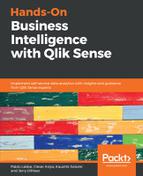When we create a chart, we select fields as the source for the dimensions and measures within the chart. For measures, we need to select the aggregation function. This process is repeated for each chart that we create in the sheet. Changing a measure in one chart doesn't affect the measures defined in other charts, even if they are related to the same field. Let's consider the SalesAmount example. Similar to when we change a field in a dimension, changing a dimension field in one chart doesn't affect the dimension defined in other charts.
It could become difficult to set the same business rule each time we create a new chart. It's also difficult to review and update all of the charts in an app when a measure expression changes. The best practice to overcome this situation is to create Master items.
Master items allow us to define a set of dimensions and measures that can be reused across various charts. This is a key function that enables the self-service creation of visualizations by business users. Changes in a dimension or measure in the Master item library carry over to the charts that are using it.
Visualizations can be added to the Master item library and converted to a linked visualization. A linked visualization can be added to multiple sheets. Changes in the linked visualization carry over to all sheets that it has been added to.
In this section, we will learn the basics of how to create master dimensions, measures, and visualizations.
